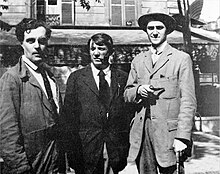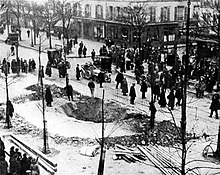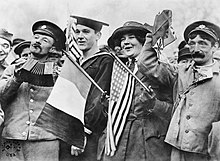Paris in World War I
Parisians entered the First World War (1914-1918) in August 1914 on a wave of patriotic fervor, but within a few weeks Paris was close to the front lines and bombarded by German aircraft and artillery.
On July 31, one day before a general mobilization was declared in France, one of the most prominent leaders of the French Left, the socialist politician Jean Jaurès, an outspoken opponent of going to war, was assassinated at the Café Croissant on Montmartre, not far from the offices of the socialist newspaper L'Humanité, by Raoul Villain, a mentally-unstable man who considered Jaurès an "enemy of France."
On August 26, the same day that the refugees from Belgium began arriving in the city, General Joseph Gallieni was called from retirement and appointed military governor of Paris, a title that dated back to the fourteenth century.
On September 2, posters appeared around the city announcing that "The members of the government of the Republic have left Paris to give a new impulse to the national defense.
General Gallieni decided to send all of his reserves from Paris to the front to aid the attack, but lacked enough trains and omnibuses to move the soldiers.
On September 5, Gallieni requisitioned a thousand private vehicles, including about six hundred Paris taxicabs and their drivers to carry soldiers to the front at Nanteuil-le-Haudouin, fifty kilometers away.
The military government declared a moratorium on rents for those Parisians who had been summoned into the army and protected them from legal action until the end of the war.
After a brief interruption, the theaters of Paris reopened, presenting plays with patriotic themes, and the cafés-concerts, which offered music, food and dancing, were crowded.
[8] Reliable sources of electricity and heat for the city population was another urgent need; the major coal mines of northern France were to the north behind the German lines.
[8] As men were drafted into the army, women frequently took their place, first as teachers and ticket clerks on the metro and tramways, then for factory working.
The aviation firm Blériot Aéronautique built an enormous aircraft factory in 1917 that covered 28,000 square meters at Suresnes.
The traditional small workshops of French industry were re-organized into huge assembly lines following the model of factory of Henry Ford in the United States and the productivity studies of Frederick Taylor on scientific management.
[10] As factory workers were drafted and sent to the front, their places were taken by women as well as 183,000 colonials from French Africa and Indochina who were closely watched by the government.
[11][12] On August 27, 1915, 1,700 Chinese workers arrived at the Gare de Lyon to take positions in the Renault tank factory and other defense works.
On October 20, 1915, a workshop making hand grenades at 173 rue de Tolbiac exploded, killing about fifty workers and injuring a hundred.
Negotiators from the clothing industry agreed to an increase of 75 centimes a day and a five-day week, but this concession was rejected by the association of employers.
The midinettes marched to the National Assembly, and on May 23, the employers agreed to raise their wages by one franc a day and to give them a five-day week.
The success of the midinettes inspired workers in other industries; the women employees of the Printemps department store and the banks promptly went on strike.
Pablo Picasso, one of those who moved to Montparnasse, was not required to go into the army (as a citizen of neutral Spain), and he continued to experiment with the new style of Cubism.
Other artists who lived in Montparnasse included André Derain (who joined the army and served through the entire war); Juan Gris; Max Jacob; and Amedeo Modigliani.
Marcel Proust, in fragile health, spent the war inside his house at 102 Boulevard Haussmann working on the second volume of his novel In Search of Lost Time.
While recovering in Paris, he wrote Les Mamelles de Tirésias and coined the word Surrealism in the program notes for Jean Cocteau and Erik Satie's ballet Parade.
Ravel attempted to enlist in the air force at the start of the war, but was found physically unfit and served instead as a truck driver.
The most significant French composition written during World War I was Ravel's Le tombeau de Couperin, completed in 1917.
On April 6, 1917, the Paris newspapers reported the welcome news that the United States, provoked by submarine attacks against U.S. ships, had declared war on Germany.
During a new attack on the night of March 11–12, a panic took place in the crowded Bolivar Métro station that caused the deaths of seventy civilians.
On March 21, 1918, the Germans launched a major new offensive, hoping to end the war before the bulk of American forces arrived.
To resist the Germans more effectively, Clemenceau insisted that the French, British and American armies be under a single commander, Marshal Ferdinand Foch.
The day was described by the French historian René Héron de Villefosse, who was a young student in a Paris college: Equally enthusiastic crowds filled the Champs Élysées on 17 November to celebrate the return of Alsace and Lorraine to France.
Huge crowds also welcomed President Woodrow Wilson to the Hôtel de Ville on 16 December 1918, when he arrived to take part in the peace negotiations at Versailles.















